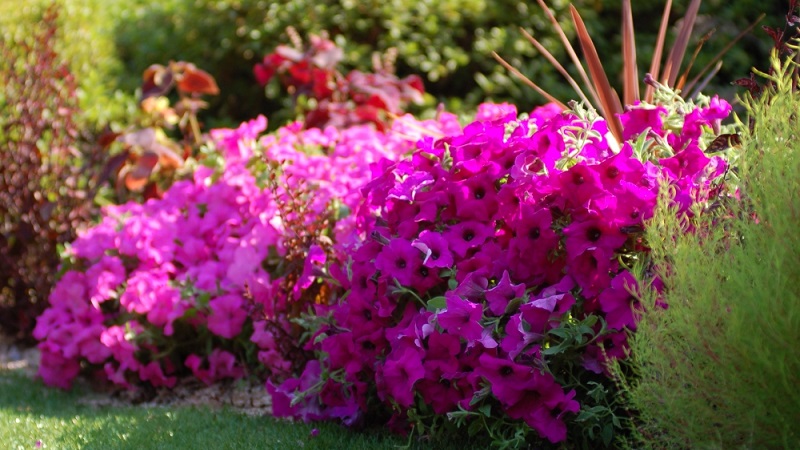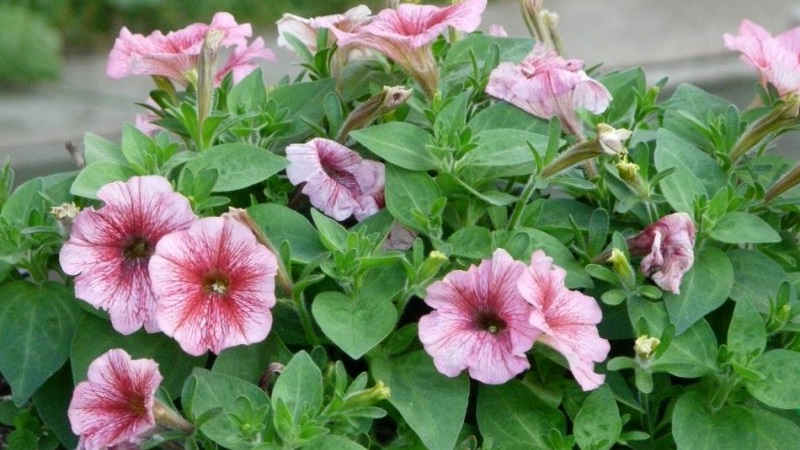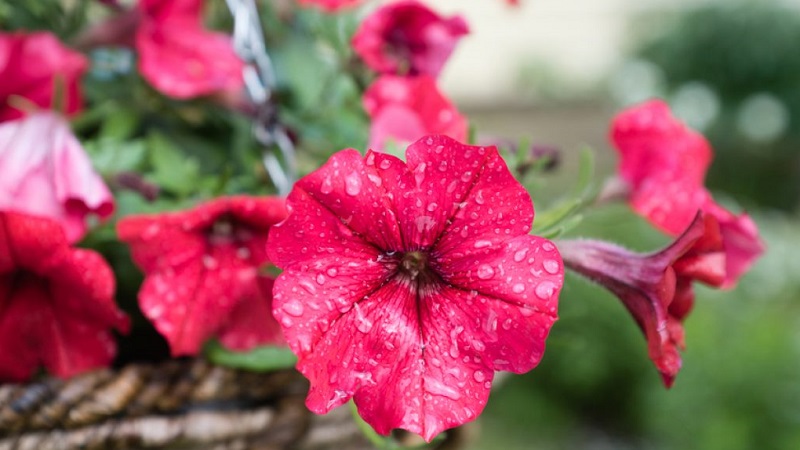How to properly revive petunia after rains, droughts or other adverse conditions
Hail, rain, rain, wind - not a single garden plant is protected from these and other weather phenomena. Beautiful multi-colored petunia is no exception. It is impossible to follow the flower 24/7, sometimes it suffers from waterlogging or drought, diseases or pests, mistakes in agricultural technology. In the article we will tell you how to restore petunia after rain and prepare it for winter.
The content of the article
In what cases does petunia need to be resuscitated
Petunia unpretentious in care. For lush flowering, summer residents follow the rules of planting and feeding, pruning and loosening... If the petunia lacks nutrition, gardeners see it immediately: the flower grows weak, the shoots are thin and lethargic, the buds are small. Sometimes flowering is delayed or does not occur at all. They also think about restoring petunias in the event that the flowers have a pale color. This suggests that petunia needs additional agrotechnical techniques. The reason for restoration and special care is waterlogging or drying of the flower.

The main reasons for the deplorable state of the flower
To save and revive petunia, it is important to find the reasons in time her deplorable state. Sometimes these are errors of agricultural technology: excess or lack of moisture and top dressing, wrong pruning, non-compliance with the landing rules. External conditions also affect the growth of a flower: temperature, lighting, rainfall. Often the cause of poor development lies in insect pests and diseases.
Care errors
Before planting a perennial plant, gardeners study subtleties of care. Petunia does not tolerate waterlogging and cold watering... It is recommended to warm it up in the sun before the procedure. Water should not get on the leaves, otherwise fungal diseases may occur, therefore watering cans or garden hoses are used for watering.
Inexperienced summer residents make another common mistake - perennials are fed only 3-4 times per season, as they used to do with vegetables. The flower needs to be fertilized regularly, about 1 time in 5-7 days. Gardeners alternate organic and mineral fertilizing, and 2 weeks before flowering, they use complex fertilizers. Petunia bloom stimulate a solution of dry wood ash, urea, double superphosphate, potassium salt.
The plant stops growing if pruning is incorrect... Every year, gardeners shorten it by 10-12 cm, sprinkle the cuts with charcoal. For the procedure, use disinfected garden shears. If you neglect this, with dirty equipment, you can introduce an infection, and the plant will get sick. This will affect the appearance of the perennial.
Attention! Sometimes summer residents make mistakes even at the stage of seedling preparation: they use dirty containers or soil with insect larvae and lumps of clay, do not pickle the seeds before planting. Because of this, diseases develop, insects multiply, and the flower does not have the strength to grow.
Unfavourable conditions
Petunia is a long-day plant, so it is planted in an open area.... This rule also applies to planting seedlings, and to move seedlings into open ground.Light is especially needed within 6 weeks from the moment of plant transplanting - the duration of flowering depends on this. If the petunia grows in a greenhouse, summer residents will organize additional lighting using lamps. Shade or partial shade is not suitable for growing a flower.
Daytime temperature must be at least + 23 ° C, nighttime - + 10 ° C... Frost can harm the plant, petunia will lose its ability to bloom and die. Especially this factor is paid attention to in cold regions of the country and, if necessary, cover the petunia with polyethylene or bring it into the house (if the plant grows in pots). Before germination, the recommended air humidity is 90-95%, after - up to 65%.
Diseases
Young and adult plants are susceptible to diseases... Some diseases are infectious, others are viral or fungal. Common causes: contaminated soil, plant debris and weeds, sudden changes in weather.

Among the diseases, summer residents note:
- Black neck... The causes of infection are waterlogged soil, a sharp cold snap, and a lack of trace elements. The black neck first affects the stem, then passes to the leaves - they dry out, curl and fall off. The stalk of the petunia becomes black, soft and rotted.
- Powdery mildew... A common disease in many garden plants. Airborne or soilborne, infects young flowers. Petunia is covered with a white bloom, metabolism is disturbed. If left untreated, she will die.
- Gray rot... Fungal disease enters the plant through damaged roots. Light brown spots appear, which become larger over time. The leaves are covered with a fluffy gray bloom.
- Iron chlorosis... Signs of the disease - small leaves, changes in the shape of buds and flowers, drying of the apical shoots. Chlorosis appears due to a lack of iron. In addition to petunias, the disease is often found on azaleas, lemon, hydrangea.
Pests
Insect pests enter the garden with poor-quality seedlings, dirty garden tools, or are carried by wind and rain from neighboring garden plots. A frequent visitor to a flowerbed with petunias is a spider mite... Due to its small size, it is difficult to see it with the naked eye - the length of the pest's body does not exceed 1 mm. Spider mites live in colonies, quickly move to neighboring plants. They suck out the juice, which disrupts the process of photosynthesis. The leaves are covered with large white spots, dry out and fall off. Ticks become active in rainy and cool weather.
Dangerous for aphids - white small flying insects... They live on the inside of the leaf and multiply rapidly. There are dozens of species of aphids. The affected leaves are deformed, the buds dry out. On the bushes you can also see thrips - small brown insects. White stripes are visible on the leaves, the plant slowly fades.
How to reanimate petunia
If it was not possible to save the petunia, it is important to take timely measures to restore it. They depend on the age of the flower, growing conditions, reasons for the appearance a particular problem.
Procedure depending on the cause
If the plant is sick, summer residents begin immediately treat using folk or purchased remedies:
- against powdery mildew - infusion of garlic (50 g per 2 liters of water) or the drug "Bravo";
- fight against gray rot with the help of "Topaz" or mustard infusion (add 2 tablespoons of powder to 10 liters of water and infuse for 4 hours);
- get rid of the black neck with Fitosporin-M or Bordeaux liquid solution.
If pests are found, use acaricides "Demitan" or "Neoron". They are used in accordance with the manufacturer's instructions, observing safety rules. An infusion of medicinal dandelion is used as a folk remedy. It prevents the appearance of aphids, thrips, ticks and other insects.
Attention! If petunia does not feel well due to an unsuitable planting site (lack of sun, low humidity), it is transplanted. To do this, prepare a container with nutrient soil. The plant is watered, carefully removed from the ground along with a lump and placed in a new container. Place the pot in a sunny and lighted place. Watered again and fed with organic matter.
What to do if petunia is flooded with rain
Due to the rains, the roots of petunias are in moist soil, which can lead to black neck lesions. Top dressing is also washed out, and the plant does not have enough strength for growth and flowering.
So that petunia does not suffer during the rains, experienced flower growers recommend pinching the tops... This will accelerate the development of side shoots and the adaptation of petunias to adverse climatic conditions.

If rain is flooded with perennials, gardeners remove spoiled leaves and flowers.... For 10-15 days, watering and feeding are stopped - this time will be spent on recovery. If the plant is more than 2 years old, the shoots are cut almost to the base, leaving 5-7 cm. After 2 weeks a new flower will appear in the pot. It is recommended to loosen the soil and add Glyocladin tablets - they strengthen the roots.
How to revive a flower after drying
It so happens that there is no rain for a long time, and there is no time for daily manual watering. Petunia dries up, loses its attractiveness. In this case, flower growers transplant the plant to a new location and water it abundantly with warm water.... It is advisable to transplant the petunia into a new pot with drainage holes, filling the bottom with gravel. The container is placed in a tray with water for 3-4 hours. All dry flowers and leaves are pre-cut. If the petunia has dried up completely, it will not work to reanimate it.
Late summer recovery
In August, summer residents reduce the amount of nitrogen fertilizing and focus on phosphorus-potassium fertilizers... They make up for the lack of trace elements, prepare petunia for the autumn-winter period. Phosphorus is essential for the proper development of the root system, potassium is responsible for immunity. Fertilizers are applied in liquid or dry form, after moistening the soil. This will protect the roots from chemical burns, the elements will be absorbed faster. Withering flowers are pinched together with a leg so that they do not take away strength from healthy ones.
Attention! At the end of summer, petunia is fed with potassium humate. Make a spray solution and treat the flower beds. The tool increases the plant's resistance to unfavorable factors, helps to endure frosts, winds, and rains.
Preventive measures
To avoid wilting petunias, gardeners pay attention to preventive measures:
- berry bushes are planted next to it;
- avoid neighborhood with potatoes, peppers, eggplants;
- water at room temperature is used for irrigation;
- once every 2 weeks, spray the flowerbed with a solution based on laundry soap;
- before flowering, nitrogen-containing dressings are applied, after - potassium-phosphorus;
- regularly inspect the plant for diseases and insects;
- use seedlings for planting.
Experienced gardening tips
Experienced florists share recommendations how to revive petunia and return its beautiful appearance:
- use garden pots with pallets or pots for cultivation;
- plant a flower in soil consisting of turf, foliage, peat, humus and sand;
- after diving, cover the plant with paper for 2-3 days;
- make sure that the flowers are always in the light;
- moisten the soil in the morning or evening;
- remove all dry shoots in early autumn.
Conclusion
Petunia resuscitation includes not always simple, but effective procedures. If you pour a summer flower, the roots will rot. In this case, summer residents remove all damaged leaves and wait until the soil is completely dry. If you dry out a perennial, its shoots and stems will weaken, the flowers will grow small. To correct the situation after a drought, abundant watering and organic feeding will help.
If the plant has suffered greatly from errors in agricultural technology, a pick comes to the rescue - the petunia is transplanted to a new place, the nutrient soil and the drainage layer are said in advance.